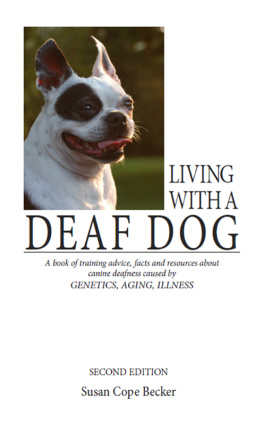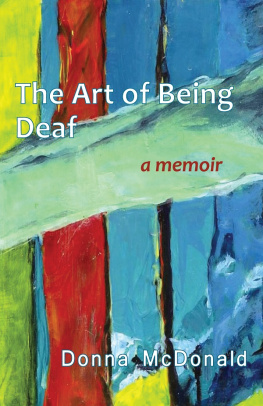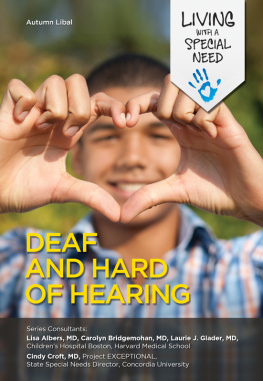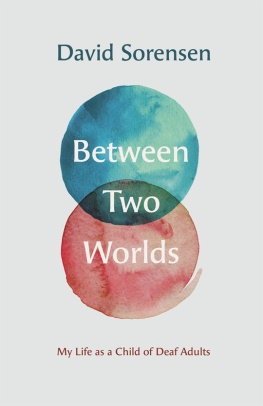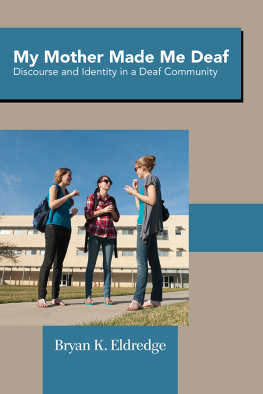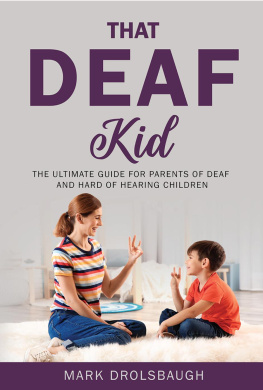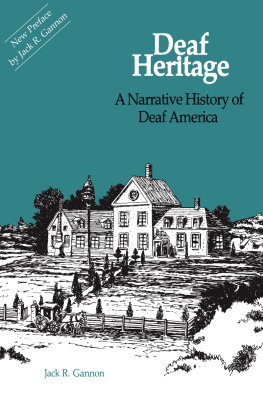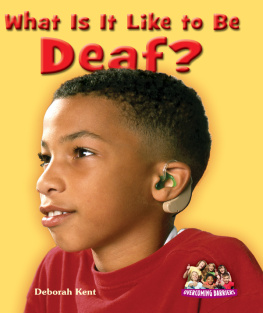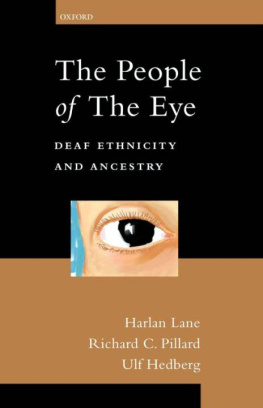WHAT PEOPLE ARE SAYING ABOUT LIVING WITH A DEAF DOG
every so often a book comes along that hits on such a timely subject that it deserves some extra attention. Filled with facts and advice from deaf-dog owners and canine professionals from around the world, Living with a Deaf Dog helps disprove myths and gives hope and encouragement to people who own these special animals.
Donna L. Marcel, Editor/DogWorld Magazine
How profoundly touched I was by Living with a Deaf Dog. What a splendid, readable and thoroughly professional book.
Susan Moldow, President, Scribner Publishing Group and Publisher of Touchstone Books, Simon & Schuster, Inc.
When I ordered the book, I thought that maybe there wouldnt be any information that was new to me because I have owned deaf dogs for almost five yearsbut was I wrong! My copy is already dog-eared!
Holly Newstead, ASL Certified Court Interpreter, EMT, Aerialist, former Deaf Dog owner
Susan Cope Beckers new book is a wonderful read! I get many calls from around the country on deaf Danes and NOW I have a book to steer them to.
Sandy Suarez, Founder Great Dane Rescue, Inc
I call it the Deaf Dog Bible. I have recommended it on a deaf dogs email site in the USA, Canada and the world for at least the last 15 years. Liz Grewal
I read your book from cover to cover. After reading it, I realized there wasnt anything I couldnt accomplish with my deaf girl! I was inspired!!!!! Joann Sesser
The book is a bible for me. I read through it so many times and also had friends and family that would be interacting with Sage. My parents (in their 90s) learn so much that my father enjoys taking him for walks and hearing what a well behave boy. Note: my dad 140 pounds and Sage is 100 pounds. Tammy Travis
I dont know how many times I have lent this book to people when they discover their pup is deaf. Super resource. Janine Carson
I use this book at the animal shelter where I work and it is an important read for the staff and the volunteers. Many deaf dogs are put to sleep in shelters, but anyone who has read Living With A Deaf Dog knows that deaf dogs are just dogs.
This is also a good book to send home with adopting parents of a deaf dog. It is a great tool to give them the confidence that they can manage and build upon the new relationship between them and their new deaf dog.
... for real people who want common sense ideas on handling deaf dogs. Nothing fancy, just good down-to-earth ideas and stories of other deaf dog families. I read the book, cover to cover, and never had any doubts on how to communicate with my deaf dog.
Coming to grips with the realities of living with a deaf dog made Susan Beckers book a good tool. Her use of ASL to communicate with her pet stimulated ideas I could use. And it alerted me to the fact that my Cavalier was reading signals which I had not noticed previously.
... this was exactly the resource I needed. I effectively taught her hand signals, she is actually a pretty incredible dog! Being handicapped doesnt mean that a dog isnt worthy of love or a long life!
Definite must-read for any person wishing to care for a dog who is deaf. Very informative.
I got to this site and found Living with a Deaf Dog. I cant tell you in words how it changed our outlook. Because of this book we had the confidence to pursue this new adventure. Absolutely a great book. Thanks for writing it.
As invaluable as this book is to actual owners of deaf dogs, it is also equally valuable to trainers to help the owners of deaf dogs. Chock full of tips, suggestions and insights from an author speaking from experience.
This is a must for anyone who has a deaf dog, anyone who interacts with deaf dogs or any shelter who takes in deaf dogs. Read this book and learn so many things you may not have discovered on your own.
LIVING
WITH A
DEAF DOG
A book of training advice, facts
and experiences about
canine deafness
caused by
GENETICS
AGING
ILLNESS
Illustrations
Andy Caylor
Henry Molter
Susan Cope Becker
SECOND EDITION
Susan Cope Becker
Published by
Susan Cope Becker
611 Mt. Peasant Road
Vonore, TN 37885
First Edition/1997
Second Edition/2017
Copyright 1997, 2017 Susan Cope Becker
All rights reserved,
including the right of reproduction
in whole or in part in any form.
Manufactured in the United States of America
Library of Congress Catalog Card Number: 2017912856
Susan Cope Becker
Living with a Deaf Dog
ISBN 978-1-61781-213-2
This book is dedicated to my Mom
who taught me how to love
and be kind to animals;
To all the people who have
opened their homes, hearts and minds
to the lovable and noble deaf dog;
To all of the people who work in deaf dog rescue,
and those who have worked tirelessly
as voices for the deaf dog;
To all the deaf dog owners with whom I have lost touch,
and to those whose letters I have not answered;
And to Spanky
one of my greatest teachers.

Nothing is impossible
to a willing heart.
John Heywood
1546


Spanky at 6 weeks old, just about the time I was told that deaf dogs couldnt be trained, and should be euthanized.
Spanky is a constant reminder to me that being normal isnt the only acceptable way to be. We all have our handicaps whether you can see them or not. Learning to love and accept that which is different is one of lifes greatest lessons, and for me, Spanky is one of lifes greatest teachers.
TABLE OF CONTENTS
CHAPTER 1 My Life with SPANKY
1996 - 2003
CHAPTER 2 DEAFNESS IN DOGS
Genetics, Aging and Illness
CHAPTER 5 Communicating with BODY LANGUAGE
Canine and Human
CHAPTER 8 THE DEAF DOGS RIGHTS
to Live Life to the Fullest

Sensory systems allow animals (and humans) to monitor the environment for purposes of self-protection, acquiring food and water, mating, communication and social interaction, and many other functions. It stands to reason that the loss of one of our senses makes life more of a challenge. Loss of taste or olfaction might not drastically affect a domestic animal, while the loss of vision or audition can impact an animal to the point of resulting in injury or even death.
Several decades ago, veterinary neurology texts only would mention deafness in passing, since so little was known about it. In the intervening years our knowledge about hearing loss in animals has made great strides, although it must be admitted that there is yet much to be discovered. We better understand the expression of the multiple forms of deafness, the pathology, and to some extent the genetics of deafness. Deafness can be (1) congenital (with birth) or later onset. It can be (2) hereditary or acquired. It can be (3) sensorineural or conductive (sound blocked from reaching the inner ear). In each case, the impact on the affected animal will differ. Conductive hearing losses can often recover, but sensorineural deafness is permanent since nerve cells in mammals cant be replaced at present although there is exciting work making progress in this area.

